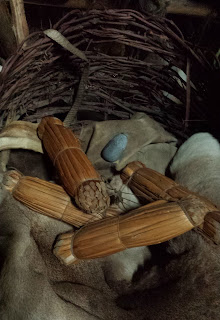So, the first part of the day was all about fun! Now it was time for some serious learning...
A tip from one of the workers at Cape Cod Brewery led us to Plimoth Plantation.
Turns out that worrying about spelling is a modern thing.
Even guys like Paul Revere, Samuel Adams and Thomas Jefferson
spelled things in lots of different ways.
"Plimoth" makes way more sense to me than "Ply-Mouth"!
The first part of the tour is a visit to a Wampanoag village.
On the right you can see a Wampanoag summer home.
It's small and made of woven reeds, and called a "wetu", or "house".
It was built for a single family of five or six people.
A native joked that they had made this one just in time for winter!
Wampanoag's have a sense of humor!
This man showed us how they ground grain, cooked stew, and roasted meat.
He wore traditional clothing made from animal skins.
This tool is used to scrape the fat off the animal hides.
That's one step in the tanning process.
The weirdest step? "Braining". That's where they rub animal brains on the hides!
Next, we visited a Wampanoag winter home.
It's bigger, made of tree bark, and is called a "nush wetu", or "long house".
This one is a small version. A "nush wetu" would hold a wife & husband, their kids, and her family. The husband lived with the in-laws.
It was heated by two fires like this one.
Bench-like beds were against each wall. Perfect for sitting or sleeping.
People would sleep side by side, with the kids snuggled in the middle.
The inside of the winter long house was insulated with reed "wallpaper".
Instead of a chest of drawers, they hung baskets on the walls.
This one is made of bark.
They also made wall baskets from reeds...
...or woven cloth.
These are tools for fishing...reed bobbers and stone weights. Very clever!
Here you can see the different oars and nets they used.
These are some of the different toys that children had, like toy dugout canoes & cloth dolls.
There's also bone sewing needles here.
Now for the Pilgrims of Plimoth...
The plantation has a reconstructed fort and a village with about a dozen homes.
About 180 people lived here originally. The first settlers arrived in 1620 on the Mayflower.
The homes were pretty basic. Dirt floors, one story living with a loft for storing food supplies.
The furniture that you see would have been brought with them from England.
On the plantation, there was always work to be done,
like chopping wood, hunting and fishing, picking crops...
...grinding corn into meal...
...feeding the animals...
...sweeping up...
All that hard work is exhausting!
Time to relax!
The final stop was the craft center.
This man was skilled at making war bonnets. He learned it from his grandfather.
The bonnets are made with porcupine hair (not the quills!).
The colorful part is hair from white tail deer, died with berries and flowers.
I asked the man is he was passing on the tradition.
Sadly...his daughter wasn't going to have any children. He was the end of the line...
After one last time feeding grass to my favorite cow, it was time to hit the road...
Philadelphia, here I come!!!!
SEE YOU NEXT TIME!






















No comments:
Post a Comment